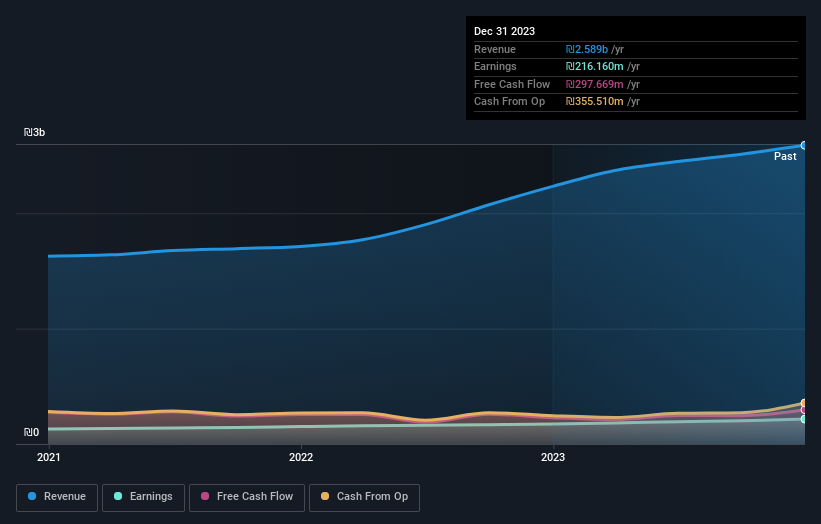Stock Analysis
- Israel
- /
- Professional Services
- /
- TASE:HLAN
Institutional investors may overlook Hilan Ltd.'s (TLV:HLAN) recent ₪259m market cap drop as long-term gains remain positive

Key Insights
- Significantly high institutional ownership implies Hilan's stock price is sensitive to their trading actions
- The top 4 shareholders own 54% of the company
- Insider ownership in Hilan is 33%
A look at the shareholders of Hilan Ltd. (TLV:HLAN) can tell us which group is most powerful. We can see that institutions own the lion's share in the company with 36% ownership. That is, the group stands to benefit the most if the stock rises (or lose the most if there is a downturn).
Losing money on investments is something no shareholder enjoys, least of all institutional investors who saw their holdings value drop by 5.1% last week. Still, the 30% one-year gains may have helped mitigate their overall losses. They should, however, be mindful of further losses in the future.
Let's delve deeper into each type of owner of Hilan, beginning with the chart below.
Check out our latest analysis for Hilan

What Does The Institutional Ownership Tell Us About Hilan?
Many institutions measure their performance against an index that approximates the local market. So they usually pay more attention to companies that are included in major indices.
As you can see, institutional investors have a fair amount of stake in Hilan. This implies the analysts working for those institutions have looked at the stock and they like it. But just like anyone else, they could be wrong. It is not uncommon to see a big share price drop if two large institutional investors try to sell out of a stock at the same time. So it is worth checking the past earnings trajectory of Hilan, (below). Of course, keep in mind that there are other factors to consider, too.

It looks like hedge funds own 5.7% of Hilan shares. That catches my attention because hedge funds sometimes try to influence management, or bring about changes that will create near term value for shareholders. Avraham Baum is currently the largest shareholder, with 33% of shares outstanding. With 9.7% and 5.7% of the shares outstanding respectively, Migdal Mutual Funds Ltd. and Noked Capital Ltd. are the second and third largest shareholders.
Our research also brought to light the fact that roughly 54% of the company is controlled by the top 4 shareholders suggesting that these owners wield significant influence on the business.
While it makes sense to study institutional ownership data for a company, it also makes sense to study analyst sentiments to know which way the wind is blowing. As far as we can tell there isn't analyst coverage of the company, so it is probably flying under the radar.
Insider Ownership Of Hilan
The definition of an insider can differ slightly between different countries, but members of the board of directors always count. The company management answer to the board and the latter should represent the interests of shareholders. Notably, sometimes top-level managers are on the board themselves.
I generally consider insider ownership to be a good thing. However, on some occasions it makes it more difficult for other shareholders to hold the board accountable for decisions.
Our information suggests that insiders maintain a significant holding in Hilan Ltd.. It has a market capitalization of just ₪4.9b, and insiders have ₪1.6b worth of shares in their own names. That's quite significant. Most would be pleased to see the board is investing alongside them. You may wish to access this free chart showing recent trading by insiders.
General Public Ownership
The general public-- including retail investors -- own 25% stake in the company, and hence can't easily be ignored. This size of ownership, while considerable, may not be enough to change company policy if the decision is not in sync with other large shareholders.
Next Steps:
It's always worth thinking about the different groups who own shares in a company. But to understand Hilan better, we need to consider many other factors.
I like to dive deeper into how a company has performed in the past. You can access this interactive graph of past earnings, revenue and cash flow, for free.
If you would prefer check out another company -- one with potentially superior financials -- then do not miss this free list of interesting companies, backed by strong financial data.
NB: Figures in this article are calculated using data from the last twelve months, which refer to the 12-month period ending on the last date of the month the financial statement is dated. This may not be consistent with full year annual report figures.
Valuation is complex, but we're here to simplify it.
Discover if Hilan might be undervalued or overvalued with our detailed analysis, featuring fair value estimates, potential risks, dividends, insider trades, and its financial condition.
Access Free AnalysisHave feedback on this article? Concerned about the content? Get in touch with us directly. Alternatively, email editorial-team (at) simplywallst.com.
This article by Simply Wall St is general in nature. We provide commentary based on historical data and analyst forecasts only using an unbiased methodology and our articles are not intended to be financial advice. It does not constitute a recommendation to buy or sell any stock, and does not take account of your objectives, or your financial situation. We aim to bring you long-term focused analysis driven by fundamental data. Note that our analysis may not factor in the latest price-sensitive company announcements or qualitative material. Simply Wall St has no position in any stocks mentioned.
About TASE:HLAN
Hilan
A software as a service (SaaS) provider, develops solutions for management of enterprise human capital in Israel.
Outstanding track record with flawless balance sheet.

